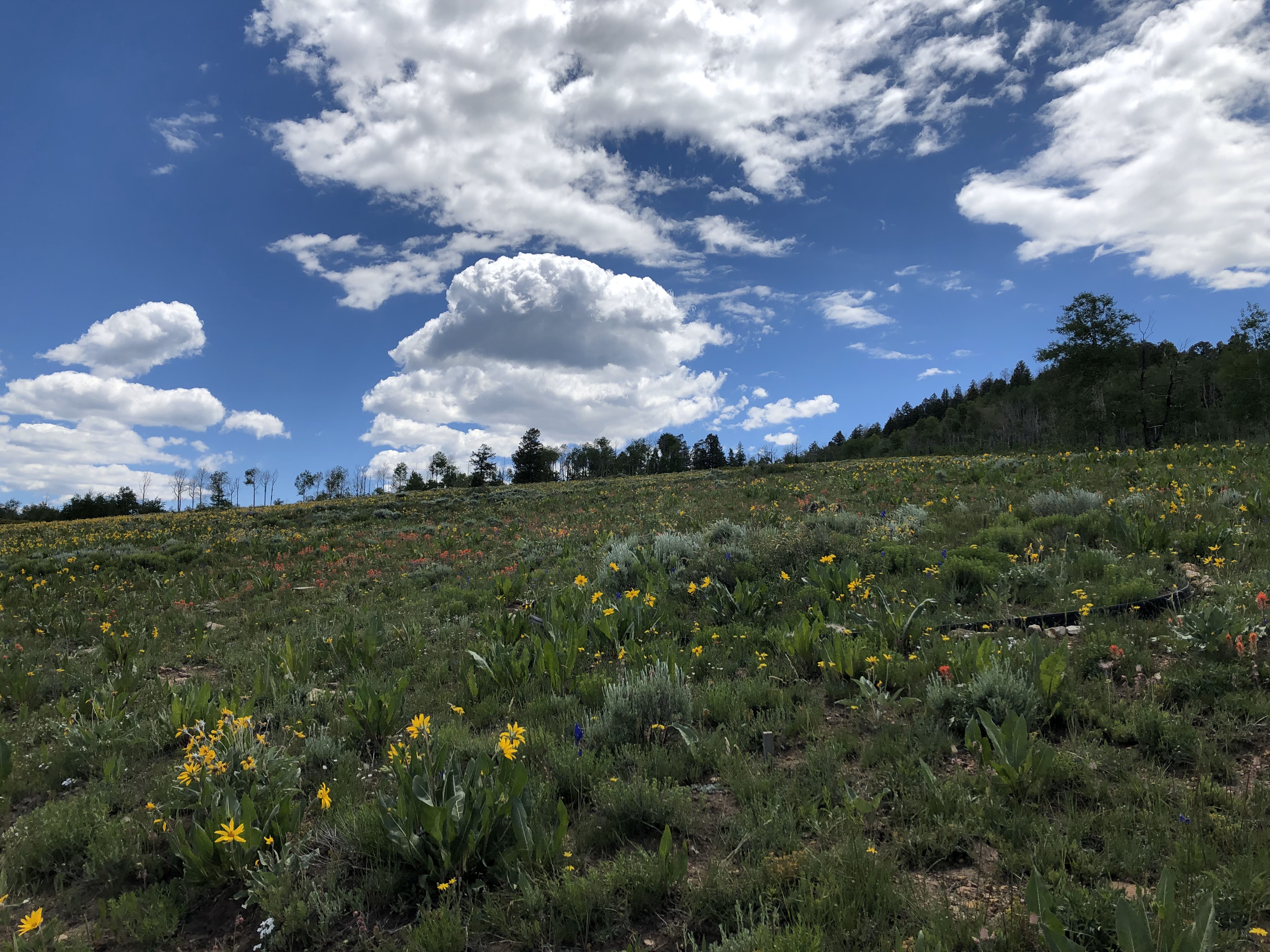Smith Lab News - 2020 archive
December 17, 2020: Risa an Nick present at AGU 2020
Risa and Nick presented some lab research at the 2020 Fall Meeting of the American Geophysical Union. Normally, AGU comprises a whirlwind week of science from all over the world. This includes talks, poster presentations, and informal conversation over beverages. This year, AGU was a bit different. Due to the pandemic, the meeting was moved online and took place nearly 24/7 over the course of 18 days. It was commendable of the organizers to do this to try and facilitate participation by scientists all around the world. Risa gave a poster presentation comprising her Masters work examining the biophysical feedbacks to the atmosphere from the implementation of cover crops. Her poster laid out evidence for a direct cooling feedback from cover cropping in West Texas. In combination with the known carbon sequestration potential of cover crops, this suggest that this land management approach could have wide-reaching climate benefits. Nick presented some recent work on the impact of optimal photosynthetic acclimation on simulated future carbon and nitrogen cycling. Using the ELM land surface model, he and coauthors found that including optimal acclimation resulted in increased future carbon uptake at lower nitrogen use (see Smith and Keenan, 2020). In the model, this saved nitrogen was used by plants to build new leaves, further increasing future carbon uptake and, as a result, land carbon storage. These findings indicate that claims of future nitrogen limitation to land carbon uptake and storage may be overestimated. Nick's slides can be accessed on his GitHub page.
June 23, 2020: Two new lab papers on photosynthetic acclimation to global change
Nick recently authored two new papers on photosynthetic acclimation to global change.
It is important to predict these responses given that photosynthesis by land plants
is the largest flux of carbon dioxide between the atmosphere at the Earth's surface.
As such, the degree to which photosynthesis acclimates to future climate conditions
will dictate the rate and magnitude of future climate change.
These goal of these studies was to further elucidate the mechanisms underlying acclimation
responses to help inform model formulations.
The first paper,
published in Global Change Biology, compares observed photosynthetic acclimation
to temperature and carbon dioxide from experiments to those predicted from least-cost
theory. Least-cost theory relies on the idea that plants will acclimate their photosynthetic
processes such that they achieve the fastest rate of photosynthesis at the least cost,
primarily water and nitrogen use. The theory is simple and based on known biological
mechanisms and thus, by comparing the theory to data, can help to elucidate mechanisms
underlying acclimation responses in ways that are not possible with traditional statistical
techniques.
The result of the data-theory comparison indicated three important tenets of photosynthetic
acclimation in C3 plants:
1. Warming increases Rubisco carboxylation to a greater degree than
electron transport. This response has been observed in a number of studies and
is the result of an investment shift to Rubisco relative to electron transport proteins
as temperatures warm. This is likely due to the fact that Rubisco oxygenation increases
to a greater rate than carboxylation with temperature. As such, a greater amount of Rubisco
is needed to maximize the light available for photosynthesis.
2. Plants decrease leaf nutrient requirements with warming and elevated CO2.
With warming, less enzymes are needed to maximize the light available for photosynthesis,
because enzymatic rates increase with temperature. Under elevated CO2, less Rubisco is needed
to take advantage of the light available, so plants down-regulate Rubisco as a result.
Both of these reduce leaf nitrogen, suggesting that leaf nitrogen demand may decrease
under future climate conditions.
3. Photosynthesis is restricted by electron transport under elevated CO2.
The theory-data comparison indicated that photosynthesis at high CO2 was limited by
electron transport, not by carboxylation, as has been previously postulated.
However, it was still unclear why this was the case. In fact, plants tended to decrease
their maximum rates of electron tranport under elevated CO2, but this was indicated as a
sub-optimal response. This understudied area of investigation needs further research.
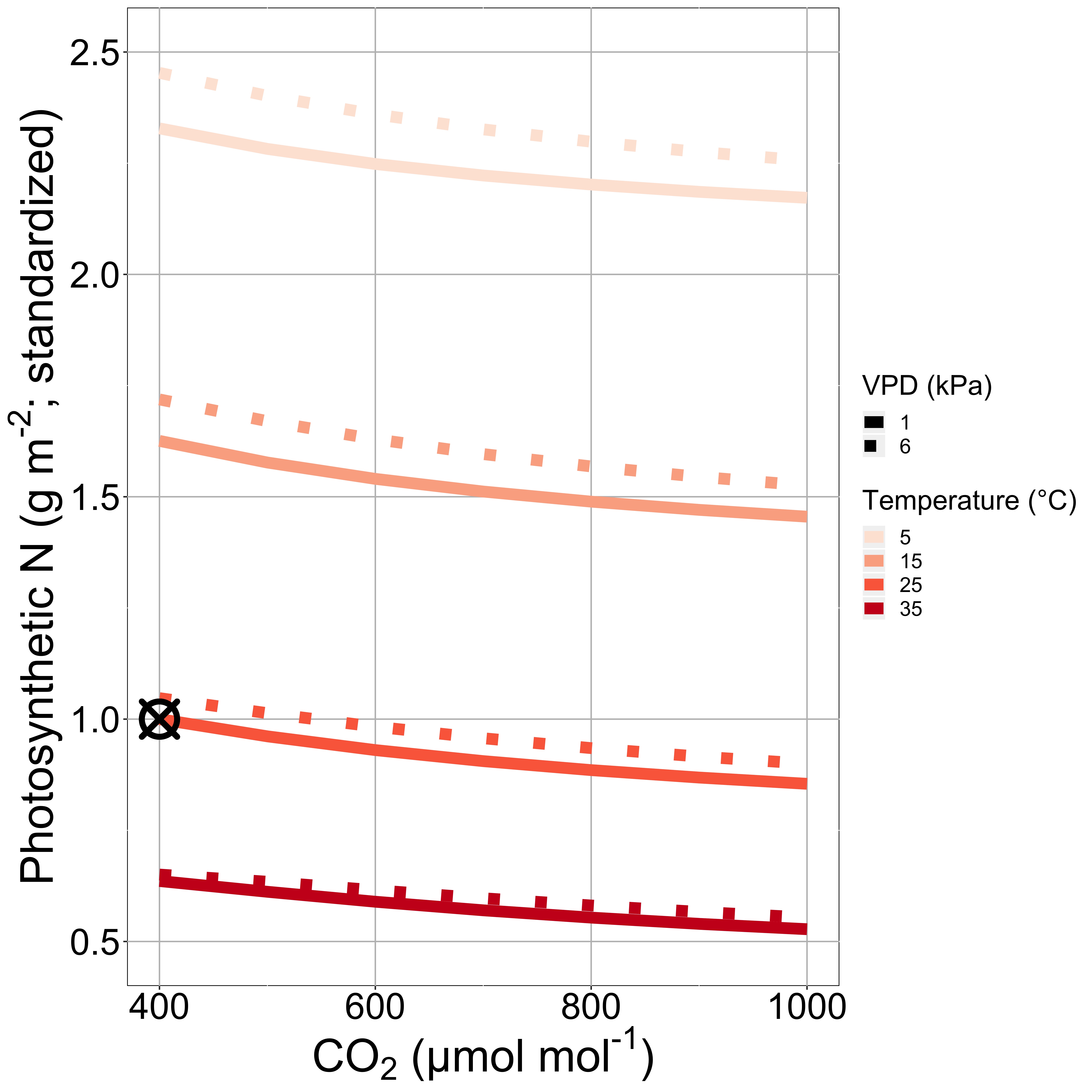
Predicted optimal photosynthetic N under different conditions (Smith and Keenan, 2020).
The full paper can be found here:
https://onlinelibrary.wiley.com/doi/abs/10.1111/gcb.15212.
The code for the model used in the paper can be found here:
https://github.com/SmithEcophysLab/optimal_vcmax_R.
Smith, NG* and TF Keenan (In Press). Mechanisms underlying leaf photosynthetic acclimation to warming and elevated CO2 as inferred from least-cost optimality theory. Global Change Biology. link.
The second paper,
published in Annals of Botany-Plants, details the result of a field study at the
Boston Area Climate Experiment (BACE)
that examined temperature acclimation of photosynthesis under multiple rainfall conditions.
Interestingly, both the warming and rainfall treatments had little impact on
net photosynthesis, but the results indicated some new insights into the context-specificity
of photosynthetic acclimation.
Interestingly, the lack of a temperature acclimation response likely resulted in
little impact to the carbon assimilation of leaves. While stomatal conductance
decreased with leaf temperature, the concurrent increase in biochemical processes
resulted in little change to net photosynthetic rates. Leaves showed a clear
decrease in assimilation at leaf temperatures >30°C, but temperatures rarely
reached that level, even in the high warming treatments.
As such, these results indicate that the plants at BACE possessed the physiological
flexibility to maintain homeostatic rates of photosynthesis under warming (+3°C) without
acclimation. Because acclimation likely comes at some cost to the plant, these
results suggest that acclimation may not occur under all conditions, particularly if
photosynthesis is likely to be little impacted without acclimation.
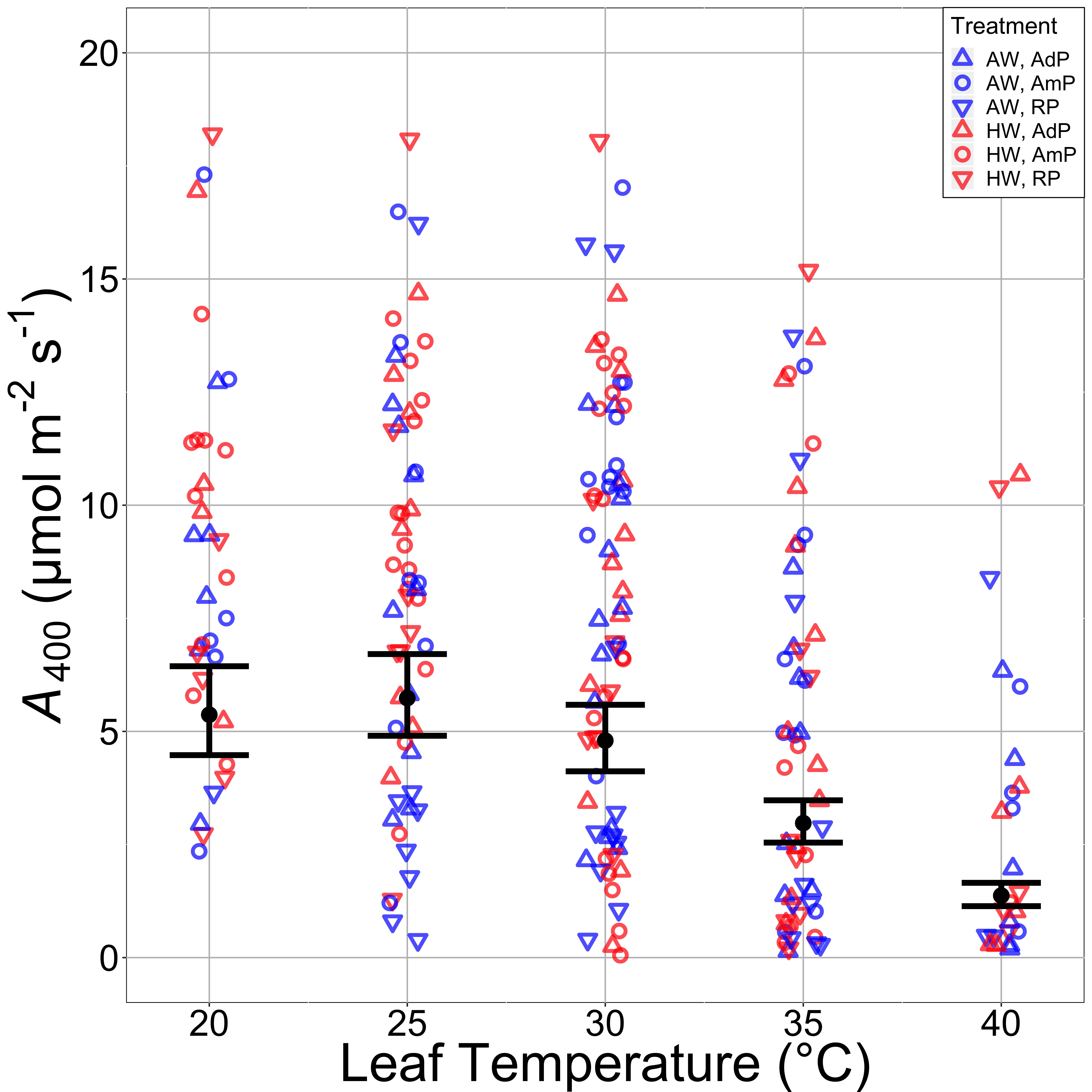
Net photosynthesis response to leaf temperature in different climate treatments (Smith et al., 2020).
The full paper can be found here: https://academic.oup.com/aobpla/advance-article/doi/10.1093/aobpla/plaa027/5860155.
The data used in the paper can be found here: https://github.com/SmithEcophysLab/bace_2016_gas_exchange.
Smith, NG*, RE McNellis*, and JS Dukes (In Press). No acclimation: Instantaneous responses to temperature maintain homeostatic photosynthetic rates under experimental warming across a precipitation gradient in Ulmus americana. Annals of Botany – Plants. link.
June 8, 2020: New lab paper in New Phytologist
Nick was involved with a new publication in New Phytologist led by Jennifer
Paillassa (University of Quebec) entitled: "When and where soil is important to modify the carbon and water economy of leaves."
The paper uses theory and data to show how soils influence leaf traits, stomatal conductance
and photosynthetic capacity (Vcmax) in particular. The paper indicates that high soil
nutrient availability relative to water availability leads to increased Vcmax per stomatal conductance.
The response is reversed in relatively high water availability soils.
These are results expected from
the least-cost theory of photosynthesis (Wright et al., 2003).
This analysis increases our understanding of how soil modify leaf traits and, because of its
link to theory, it enhances our ability to reliably model these responses.
In his PhD work, Evan will be using experiments to follow up some of these results.
Watch this space for further updates!
The full paper can be found here: https://nph.onlinelibrary.wiley.com/doi/abs/10.1111/nph.16702.
Paillassa, J, IJ Wright, IC Prentice, S Pepin, Smith, NG*, G Ethier, A Westerband,
LJ Lamarque, H Wang, WK Cornwell, and V Maire (In Press).
When and where soil is important to modify the carbon and water economy of leaves.
New Phytologist.
link.
May 28, 2020: Risa successfully defends her thesis on biophysical feedbacks from cover cropping
Risa successfully defended her Masters thesis entitled Leaf traits drive increases in albedo and latent heat flux of winter cover crops.
Risa's thesis looked at the mechanisms underlying the biophysical impacts of winter cover cropping.
She found that changes in leaf and whole-plant traits drive differences in albedo and latent heat flux
between winter and summer crops. She also found that winter cover cropping can increase both
albedo and latent heat flux as compared to land that is left fallow over the summer.
Together, these two chapters indicate that winter cover cropping will have a cooling
effects on the land surface, at least in West Texas.
Risa's novel suite of measurements have now improved our understanding of these processes
as well as our ability to model them.
Great work Risa!!
May 7, 2020: Some lab accomplishments as the 2020 Spring semester comes to a close
The Spring 2020 semester was certainly a unique one! Despite a major bump in the road
with the closing of campus and shut down of research activities due to COVID-19,
there were still a ton of accomplishments. Some highlights:
Risa submitted her masters thesis to her committee, which she will defend this summer.
Risa's masters work culminated in two chapters that will comprise two manuscripts.
In the first study, she quantifies the mechanisms underlying differences in winter and
summer crop albedo and stomatal conductance. In the second, she used a more targeted study
to define the drivers of winter crop albedo and latent heat flux. These novel results
(and data!) will hopefully help define these critical processes in land surface models
as they continue to incorporate more agricultural practices.
Evan successfully completed and presented his PhD proposal. He has outline four exciting
projects that will constitute his thesis examining coupled aboveground-belowground
processes and their impact on leaf-level and whole-plant processes. The proposal included
a novel combination of theory and data (both observational and manipulative) that,
once completed, will improve our understanding and ability to model the interactions between
plants, microbial symbionts, and soil nutrition under global change.
Abigail finished her undergraduate research project examining forage grasses suitable for
agricultural reclamation on saline lands. Using four species grown under different levels of
soil salinity, she quantified salinity tolerance as well as impacts to leaf nutrition via
leaf carbon and nitrogen measurements. She is writing up her results for publication,
a huge accomplishment from an undergraduate project!
Way to go everybody!!
May 7, 2020: Two new biochar articles
Nick, along with colleague Jeff Licht (UMass-Boston), published two new articles
examining the use of biochar to improve plant performance in two different contexts.
In one article, published in Frontiers in Forests and Global Change, we found
that anthropogenic biochar had a similarly positive effect on pitch pine (Pinus rigida)
performance as natural biochar in a Massachusetts forest. Fire has been suppressed for many years in these
forests for many years and anthropogenic biochar provides an avenue for adding back in
some of the positive soil effects of fire, without having to use controlled burns.
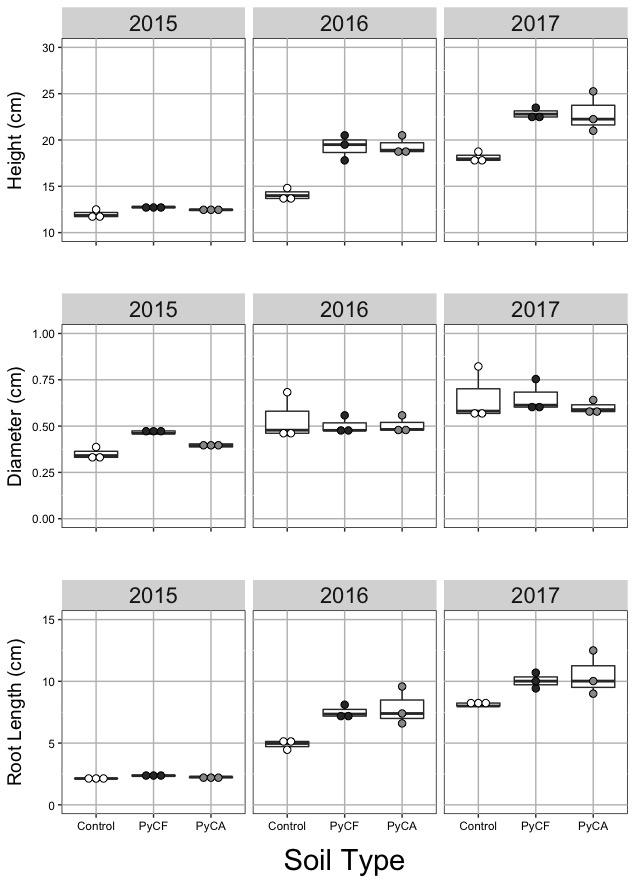
Growth measurements of pitch pine grown with control soil, forest biochar amended soil (PyCF), and anthropogenic biochar amended soil (PyCA) (Licht and Smith, 2020).
In a second article, published in the Israel Journal of Ecology and Evolution, we found that biochar improved the physiological performance of wild indigo (Baptisia tinctoria) grown on a green roof in Massachusetts. It is difficult to grow perennial C3 plants on green roofs due to the necessary use of poor, shallow soils. Our results show that anthropogenic biochar may improve soil quality and boost the performance of wild indigo, results that may be extended to other species that are hard to grow on rooftops.
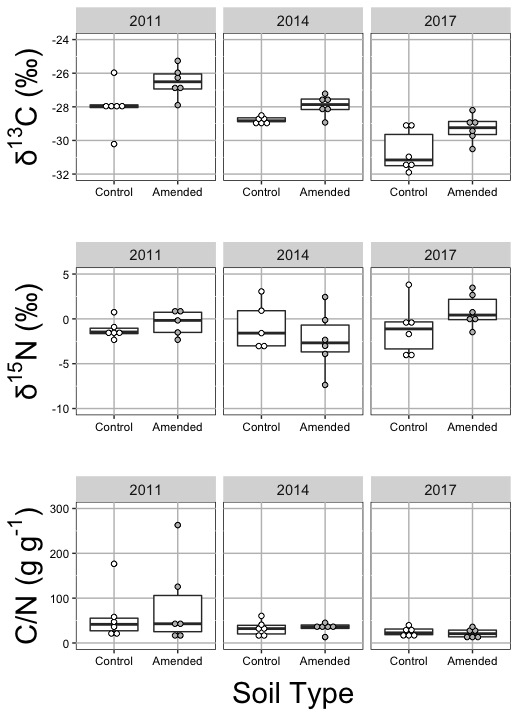
Leaf traits of rooftop wild indigo grown under control and biochar amended soils (Licht and Smith, 2020).
Please contact Nick if you have trouble accessing these articles.
April 5, 2020: New model publication: P-model version 1.0
Nick contributed to a recent publication
led by Beni Stocker (ETH Zurich) that details a new land surface modeling scheme for simulating GPP based
on plant optimality. The model, called the P-model, simulates terrestrial GPP following
theory developed by members of the authorship group, most notably Wang Han (Tsinghua University)
and Colin Prentice (Imperial College London).
In the paper, we test the model against observational data, showing that this simple model
can capture many observed spatial and temporal dynamics in GPP (r2 = 0.75 across 126 sites).
The model includes tractable and testable mechanisms that we hope to improve upon
in future modeling and experimental studies.
The model is freely available as an
R package and we encourage its use by other interested research groups.
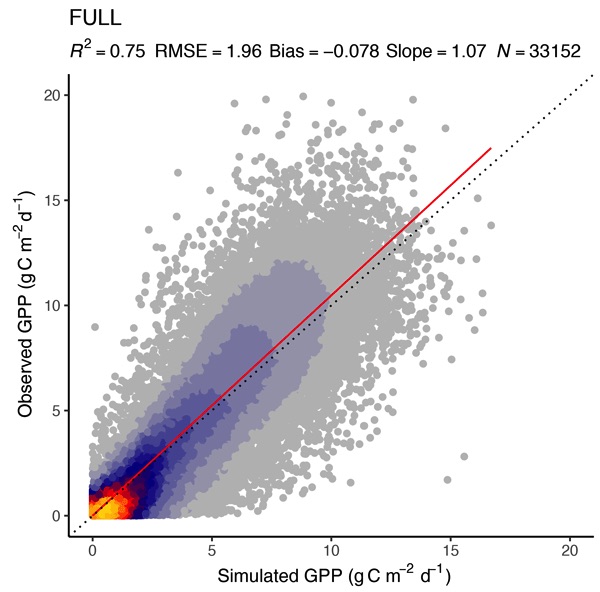
Figure 3a from the paper showing the comparison between observed and P-model simulated GPP (Stocker et al., 2020).
February 29, 2020: New publication on optimal respiration
Nick was part of a study led by Wang Han (Tsinghua University) on optimal leaf dark respiration that was
published
as an Early View article in Global Change Biology this week.
The paper explores a new model that predicts leaf dark respiration from photosynthetic least cost
optimality theory. Specifically, the paper tests the theory that much of leaf dark respiration
is used to maintain Rubisco carboxylation. The model predicts optimal rates of carboxylation
under varying environments, as well as the ratio of dark respiration to carboxylation
under varying environments. From this, the temperature sensitivity, and thus optimal
temperature acclimation of leaf dark respiration can be predicted.
The analyses indicated that the optimal model matched the empirical data.
This indicates that leaf respiration in predominantly driven by changes in Rubisco
carboxylation and that this response can be predicted from an optimal photosynthesis model.
The model was developed such that it can be easily incorporated into land surface models
as a means to improve their reliability.
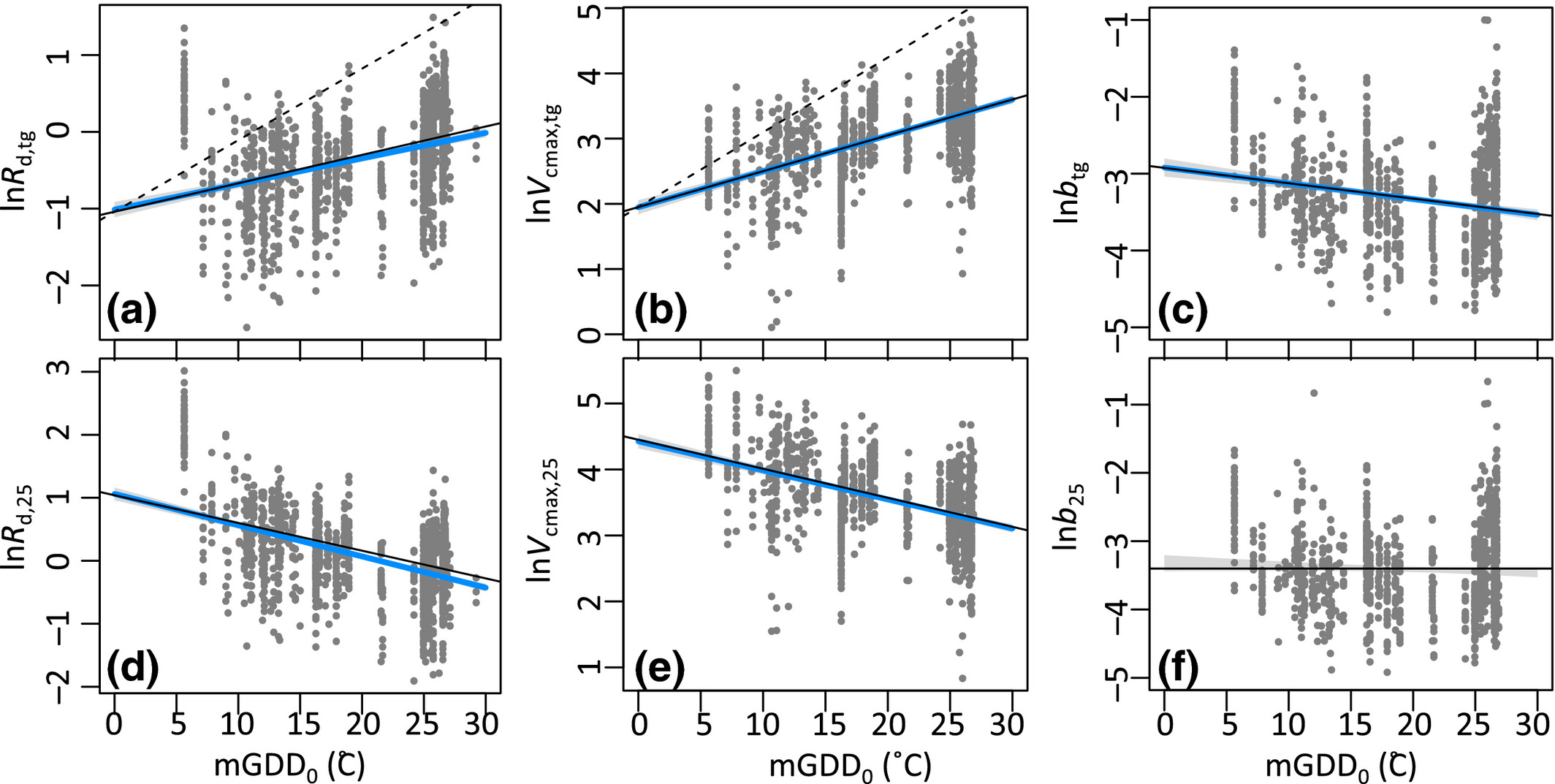
Figure 2 from the paper showing leaf dark respiration (Rd), maximum carboxylation capacity (Vcmax) and their ratio (b) as a function of growth temperature (mGDD0). Top panels show Rd and Vcmax standardized to the growth temperature and bottom shows rates standardized to 25°C. Blue lines are lines fit to the data. Black lines are theoretical predictions. Dashed lines are instantaneous temperature responses.
February 19, 2020: Heather McCarthy visits the lab and TTU
Oklahoma University professor Heather McCarthy visited Lubbock to speak to the
Biology department about all the cool Southern Great Plains ecophysiology
she is doing. Heather talked to us about switchgrass drought tolerance,
red cedar encroachment, and urban plant resilience to climate change.
We were also able to chat with Heather about the cool research folks are doing here,
which included a visit to the lbb.us Nutrient Network site.
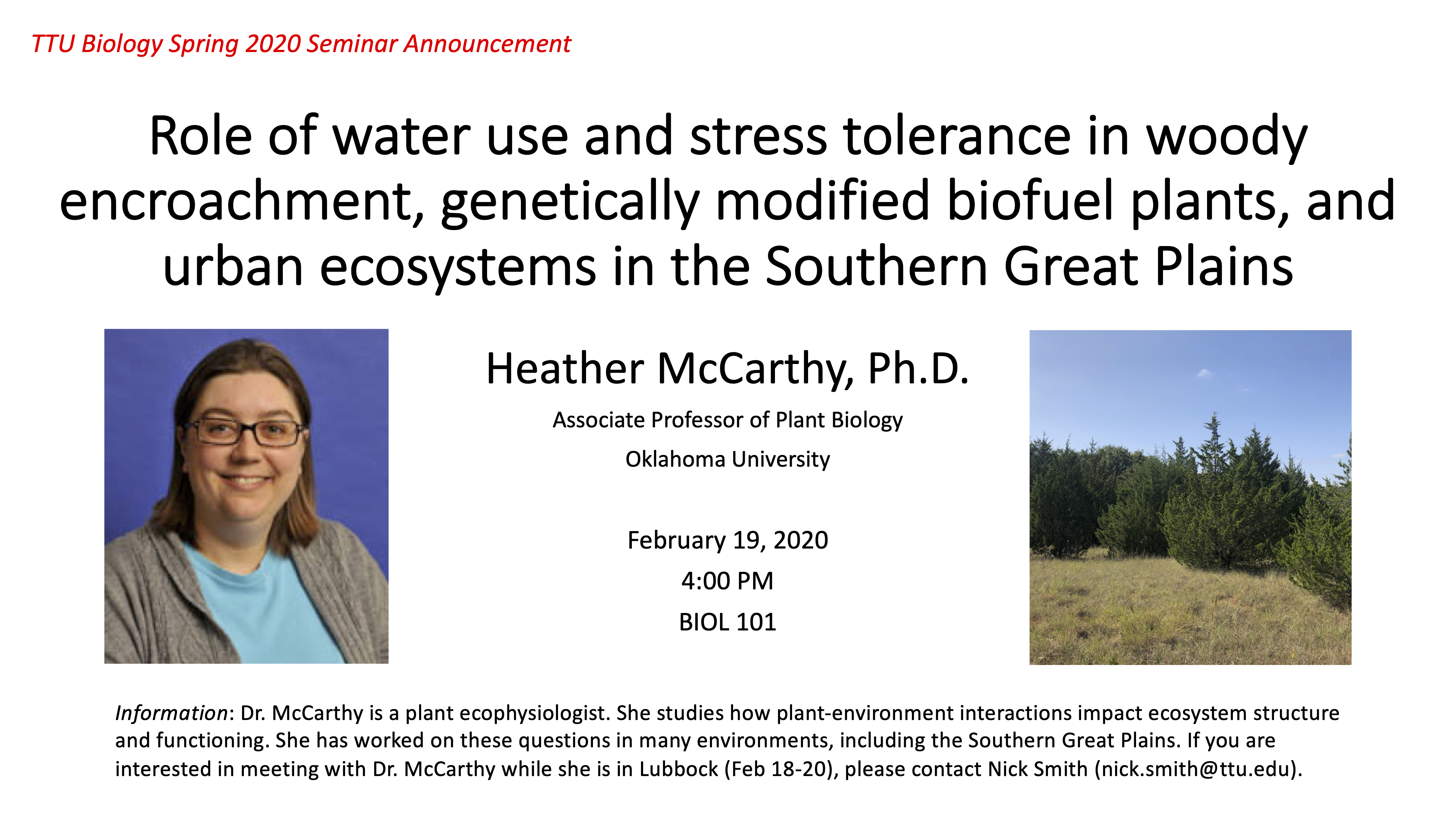
January 18, 2020: Nick gives an outreach talk to the Texas Native Plants Society
Nick visited Alpine, Texas to give a seminar on the resilience of West Texas flora
to the Big Bend chapter of the Texas Native Plant Society.
The talk was part of a program on the potential impacts of climate change
on the flora of the Big Bend and Trans Pecos (pronounced "paycos" as Nick was reminded!).
The talk was attended by concerned citizens and scientists alike. Nick presented
some reasons for optimism for the local flora (West Texas plants are tough!), but
also some reasons for concern for the region. In short: while these plants have the physiological
capabilities to withstand future climates, impacts at higher ecological levels could
be detrimental. These include community- and ecosystem- level impacts. Nick's talk
can be accessed
here.
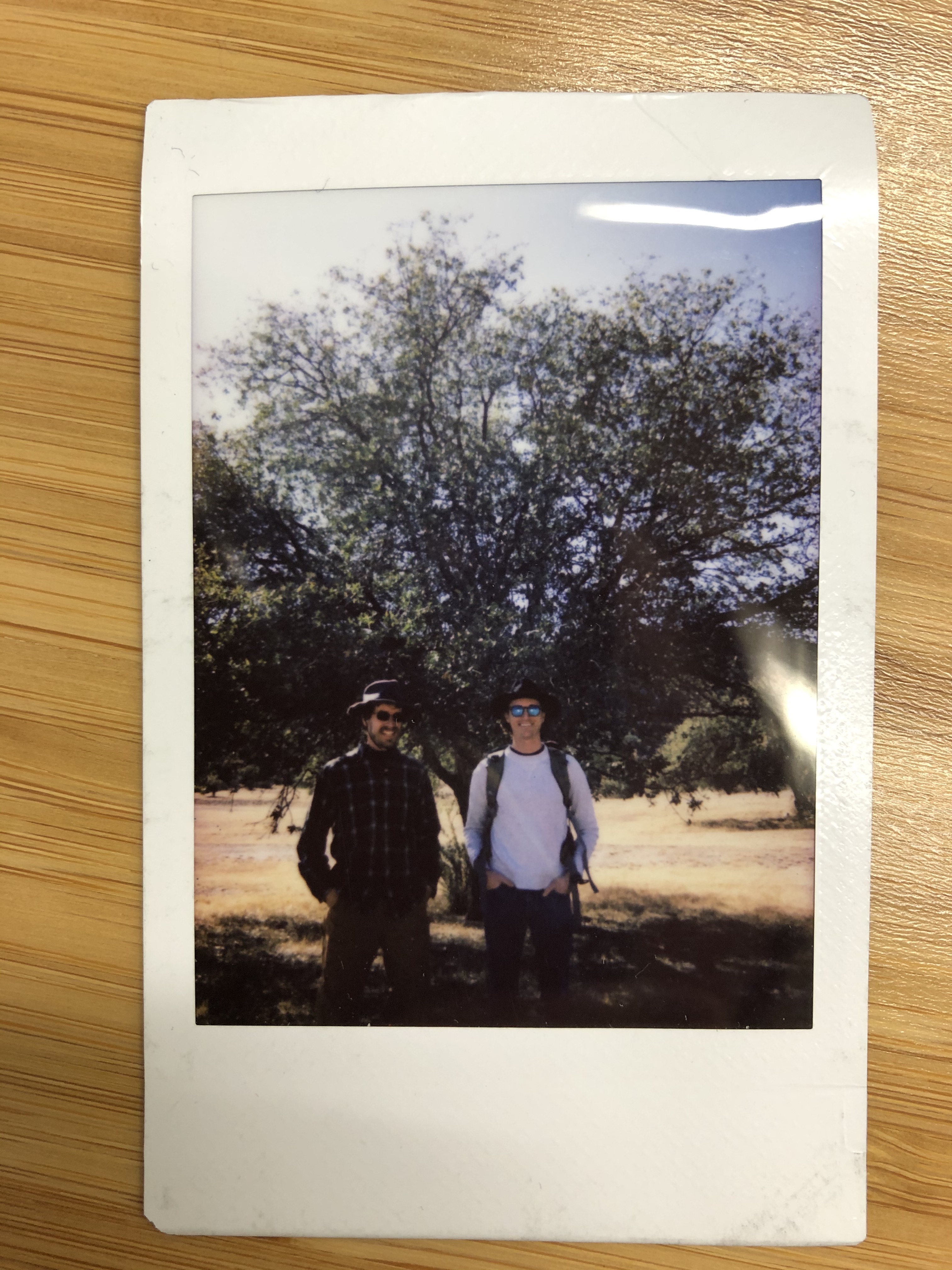
Nick with fellow seminar speaker Dylan Schwilk visiting Fort Davis after the talk (photo credit: Stella Rose Smith).
January 17, 2020: Last year in review
2019 was an amazing year for the lab! It's
awesome to work every day with such talented colleagues and students.
This past year saw 7 lab papers published or accepted, 5 proposals funded,
and 18 presentations given. Some highlights include (click each for full blog):
- Helen received her Masters degree
- Lizz got a tenure track job at NSU
- Risa won a grant for her cover crop work
- Abigail won a research grant
- Evan and Risa sampled canopy leaves in New York
- Many lab members presented at ESA
- Ricky Kong spent the summer with us
- Our USDA-funded potato physiology project got off the ground
